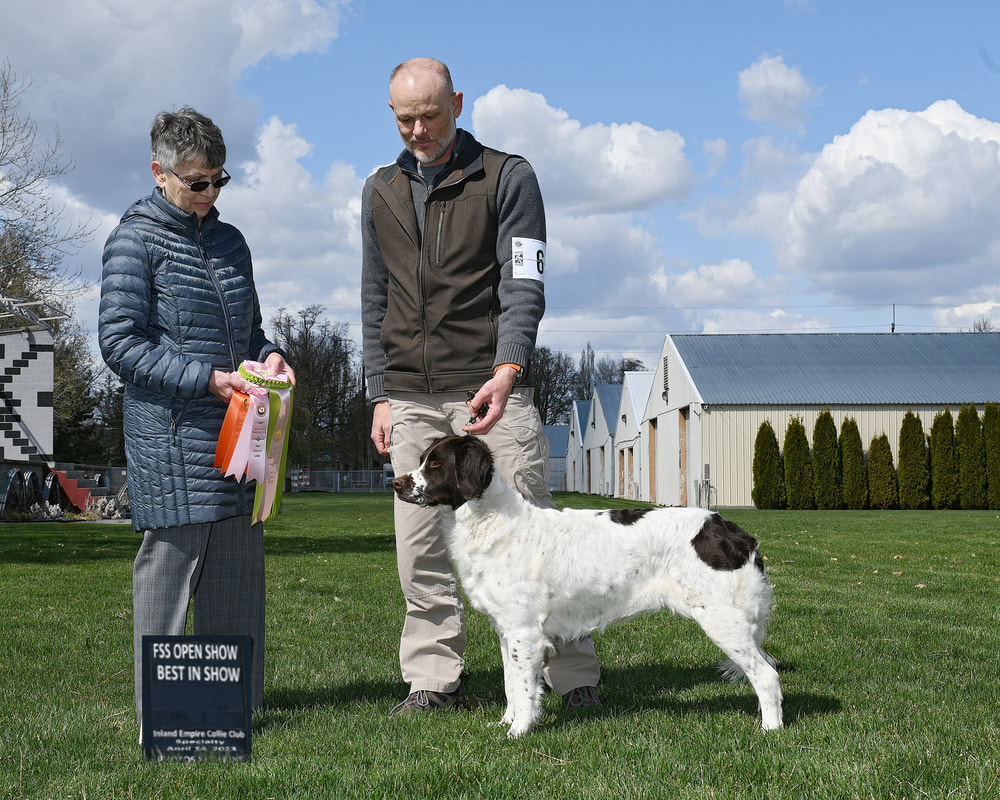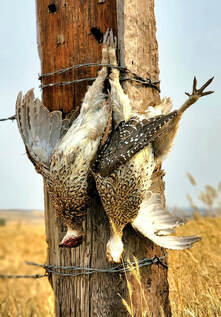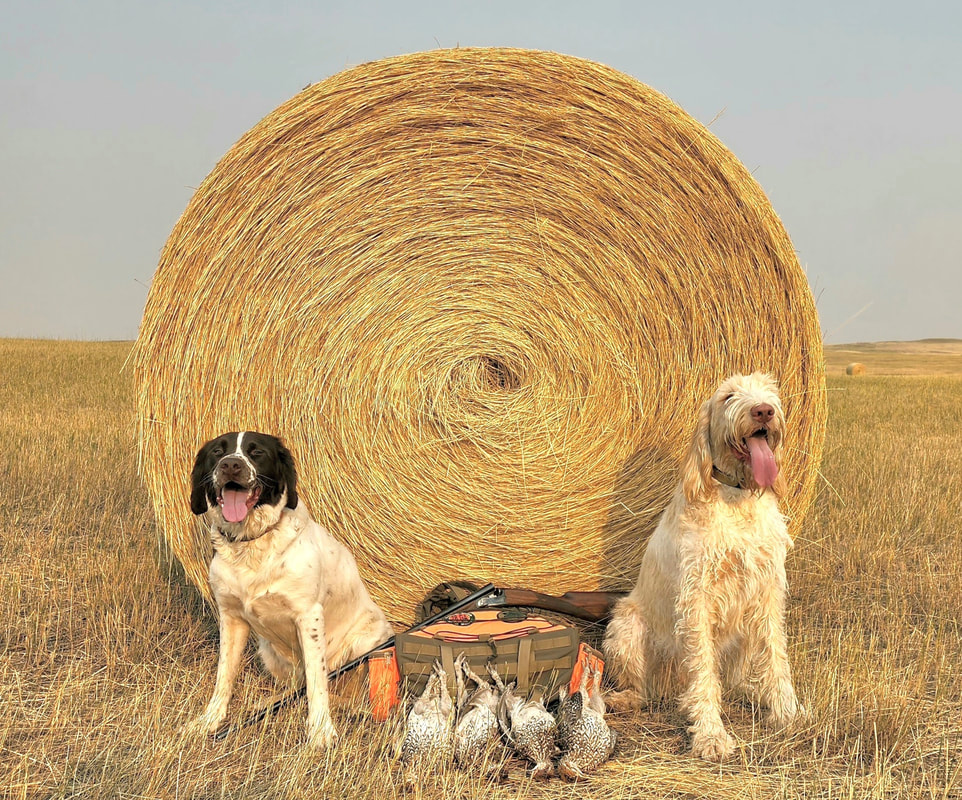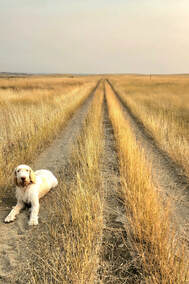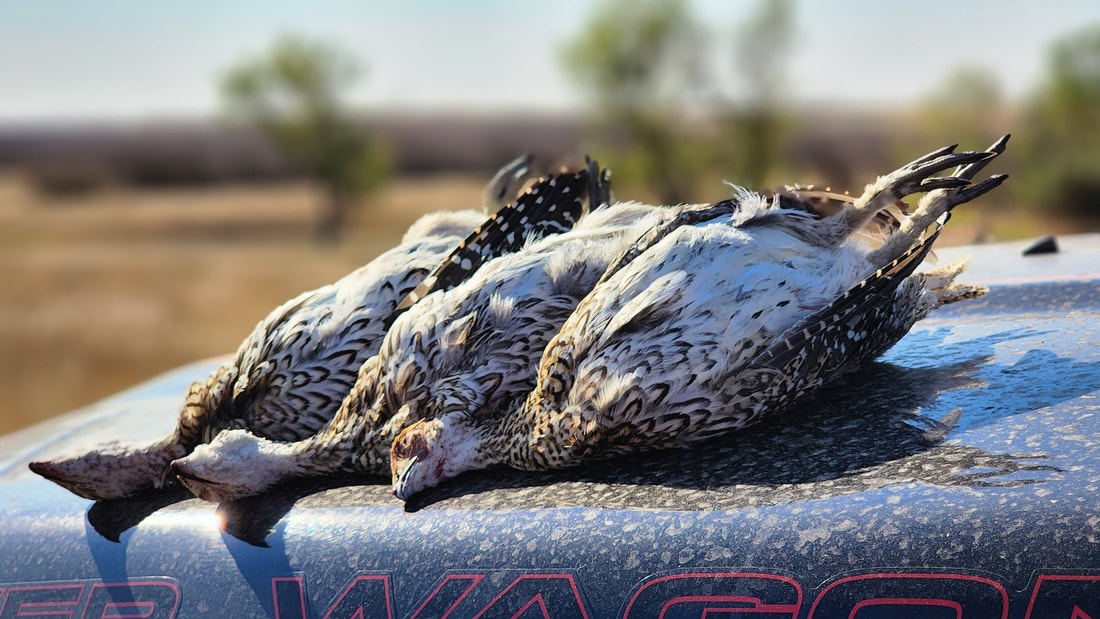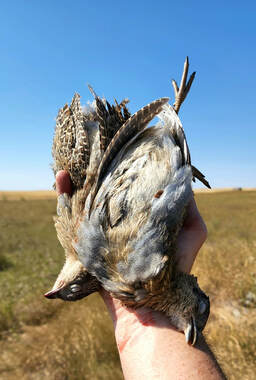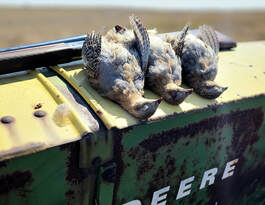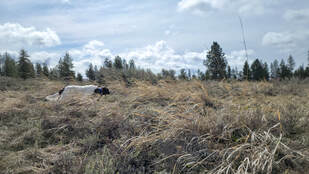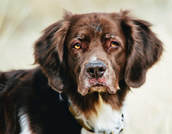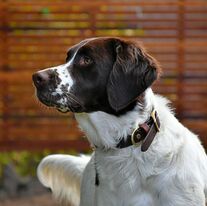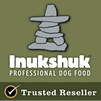0 Comments
In memory of Fowler: 10 May 2010 - 26 April 2023 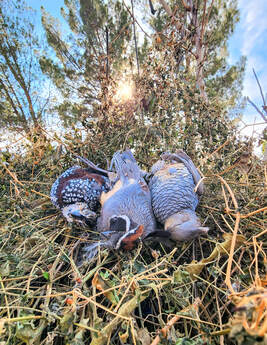 Since you are reading this, it is a safe bet we are back in cold, dark, and wet Spokane and we are no longer in the business of shoveling sunshine and hunting quail in the high desert. I could make this the shortest recap ever: we had a great trip. But then that isn’t a lot of fun now, is it? A week prior to heading South for the big Pheonix dog show, Jenna had gone to Oregon to help our friend Stacey. It was an eventful stay, and to say the least, Stacey was helped, as was Mr. Kim & Laura. A made for TV drama if there ever was one. As an added kicker, she contracted COVID and it hit her while on the 9-hour drive home. Jenna did a turn and burn move, and we left with her having barely 24 hours at home. It is a full twenty-hour drive from Spokane to Pheonix, and all was going well until we were about five hours out – the VID hit me like a freight train, and I had to pull off the road. Driving was no longer possible for me. Day one I missed the dog show, then life began to return to me. We wore our masks, and stayed away from people, which was pretty easy to do at the enormous West World horse pavilion. Ila did pretty good in her Open shows, and Fizzy did well in all of hers, as we have come to expect. After the show cluster ended, we headed further South and got started with some desert quail hunting.  My buddy Jacob had invited us to check out an area he liked for desert quail, and it turned out to be an amazing time. In the low spots there were Gambles quail in abundance, on the ridges, there were plentiful numbers of Scaled quail. Wow! I even took a Scamble, a primarily Gambels quail with Scaled quail feathers on its chest – super cool! The different species in this location literally were a few yards apart in many places, very easy for overlapping and Scambling to happen. Good times were had, and we are still grateful for the opportunity to hunt such a cool place. With the Mearns opener on the horizon and a hunting buddy from Spokane coming down to fulfill a lifelong goal of hunting Mearns quail – we were hyper focused on getting into birds. Not just hunting our usual coverts. But to continue something we started last year. Jacob and I had a friendly competition running on finding new and unique coveys. I had stopped marking coveys a long time ago, and had just hunted haphazardly here and there, and many times into the most rugged and insane habitat the birds would live in. A sure-fire way to find birds in the hard and down years. After a few friendly jabs, I started marking my covey finds last year. We ended that season with over 80 new to us finds, which was pretty cool. More importantly it got us thinking more deliberately about where we hunted, and how we hunted the areas we did hunt. We were never really keen on repeating hunts, even in the tough years, but this new game really got us thinking. 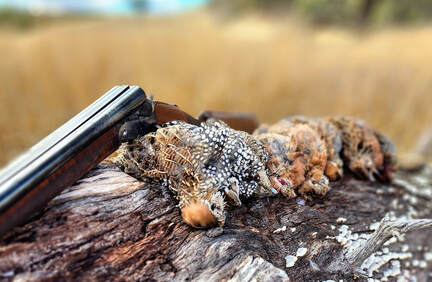 Jenna and I spend our summers training, showing, and fooling around with our dogs, but also, we have an unusual hobby of tracking rainfall for the areas we prefer to hunt in Arizona. Mearns quail populations are tied directly to the summer monsoons. So, knowing when and where the rain fell would likely help us to produce more finds. One might think this would be easy since rainfall data can be found with relative ease on the internet… but not if the primary area you hunt, over a million acres, doesn’t have any rain gauges! We use a myriad of odd sources, and spend time watching the active weather radar, which helps us to identify areas of interest. I then draw borders on these areas in OnX for us to go and investigate using boot leather. This past season was a high-water mark with how extremely systematic we were with this approach. In all we located and identified over 140 new and unique coveys for us during our thirty days of Mearns hunting. We did hunt a few Old Hunts so our total covey count was a good bit higher, but what really interests us is the “new to us” category. It serves to validate our methodology and makes the exploration into the unknown even more rewarding. We rarely hunt past noon, that more or less makes us “half-day” hunters down there. Say what you will, but we aren’t there to make money. Making it back to the house by one or two in the afternoon to eat, shower, relax, and enjoy some of what the area offers is also part of the package for us. We are proud of what we do and how we do it, one or two dogs on the ground at a time, a casual pace, and short-ish days. If you are running three or four dogs at a time, doing a crew swap at lunch to have fresh dogs on the ground and hunting until dark – well, I’d hope you are finding more – better yet, do some better hitting and you’ll have to stop! Most folks I compare notes with find much fewer coveys and spend a good bit more time walking…but I digress. 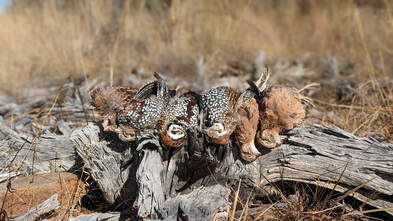 We’ve also always kept a soft count on covey finds for each dog, but this year, and the number of birds we were finding got a little more serious in this department as well. The Leader Board Emerged. We established a few easy rules. Coveys would be counted even if the dog made errors, it just happens e.g. bumping. If we were running two dogs and they both pretty much tied into the covey at the same time both got credit. If one was on a covey first, they got solo credit, the backing/cooperating dog was along for the ride. We joked about figuring out a handicap in the event a dog with a bunch or errors passed a dog with few to none…it was close, but it didn’t happen. So, for now that will remain a project for another day. You may find the results surprising. The Old Guy Fowler came in last, but also with the fewest days hunted by far, with 14 coveys. Tule was 4th with 15 coveys. The Queen of Mearns Hunting (8 seasons), Powder, came in 3rd, with 35 coveys. Ila was second with 51 coveys. Fizzy, in her 2nd hunting season, came in 1st with 54 coveys – also with the fewest errors by far! What does it all really mean? Well, having several months to reflect on this I can say we had a grand time! We hunted with new and old friends, had dog work I couldn’t have dreamed of just a few years ago. I my shooting was always on point (that’s a joke kids), and at times it was the things that fuel the creation of colorful memes, but I also had days where my hitting was literally the stuff that gets written into song. If I never had a Mearns season like this past, at least I had it as an incredible high-water mark to remember contemplatively while enjoying some fine libations with the sun on my face. Hello friends! I realize I have been entirely derelict with making regular posts, and even getting the couple I promised finished and posted. I am still nibbling away at them - I promise. We took a year off from producing a litter for ourselves, to catch up on life and to do some things we had been meaning to do but couldn't because we had a litter on the ground. If you follow @TwoGunKennels or @Two_Gun_Kennels any, then you have a few ideas of what we have been up to...
One of the things we have been wanting to do is work on Ila's Certificate of Merit, as close to a Champion title a breed in the AKC's FSS can aspire to within that system (aside from multiple CM's). The preponderance of Open Shows in our region take place in the spring when she would have puppies on the ground. Even then, there just aren't many offered, and most are four or more hours away... The few remaining Open Shows are sporadically offered during the time she drops coat, and frankly looks her worst. We had a nice weekend at the Moses Lake show cluster where we all did well, with multiple group placements for all the dogs we had entered. However, Ila was given the opportunity to make history again! That's right, last summer, with a rough coat, she was the first female Drent to win a Best in Open Show (BIOC, Best in Open Conformation - yes, it is a bit confusing...), and as of Friday, 14 April 2023 she is the first female Drent to win multiple Best in Open Shows in AKC History! Another proud breeder moment: so far, our paternal line coming down from Esp. Ch. Joksan NABAR the Gloucester has produced all the AKC's Best in Open Show winners to date. Not a lot to say, other than we had an exciting time and definitely found our share of birds. We hunted hard and the girls did some excellent work and upped their game to meet the edginess of the mid-season birds. Not to be mistaken for the puppy friendly early season birds... Each dog was able to work and point Pheasant, Hungarian Partridge, and of course, Sharptailed Grouse on this blitz style 5-days of hunting trip. Sadly, I started off by missing some great opportunities to take game I had been gifted with. However, I managed to find my mojo at an undisclosed location and started filling the bag and completing great hunting sequences for the girls - which was nice. Here are a few shots, in no particular order, from the trip. During hunting season, we have been taking some time to moonlight for Sage Canyon Outfitters guiding discerning clients on preserve hunts. I get to hunt the girls at least twice a day for some really good folks. The sets are rather generous, and we can easily expect 25 to 50 points per hunt... tailgate photos are about half the birds taken on each hunt (I must do a drop and call for support). Tule likes to sneak in for the group shots, while Ila and Powder prefer to lay in the shade and drink water, Fizzy tends to be all business unless there is mud to roll in. Here are only a few of the group photos from that vigorous five days! Enjoy
Mountain grouse, as they are called in Montana, are not for those weak in the knee or faint of heart. Sure, you don't need to be in Boston Marathon shape, but that would help a lot. I stayed with my longtime friend and we hunted with our collective friend who is seventy-six years of age! I hope to be at it like him when I get there! The easiest Dusky Grouse habitat in their area isn't really easy. You just take it easy, one step at a time, and trust the dog(s) to do their work. Since we don't sluice birds off the ground or out of trees, the shooting is a real challenge and means hard found birds can be lost as they make their escape through thick cover. A change in temperatures for the better, read coolerr, got the broods moving and we made good contact each day. Ila had injured a toe on the last day of her prairie hunting, and so it was eighteen-month-old Fizzy who hunted every day from the start to the end of the trip. Ila did get to hunt in the mountains for the morning hunt before we left town.
I got into birddogs later in life, but I have always been nutz about dogs, to include their training, learning, and later their conformation/structure, breeding and so on...
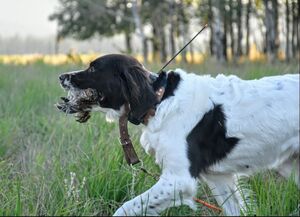
My Air Force career kept me from doing many of the things I wanted to do with my dogs. Long hours, working on my days off, deployments, travel, etc. A real sob story. So being able to do the "field work" I wanted to do with them was a far-off dream. These days, as long as things are working halfway decently, "playing with my dogs" is what I do.
Powder was initially trained by Dan Hoke of Dunfur kennels just outside of town. Dan is a GSP guy and has a field trail resume few can equal. Moreover, when Dan was a young fellow, he was an apprentice to Sigbot "Bodo" Winterhelt - The Bodo Winterhelt! Dan is a gifted dog handler for sure, and I will forever love watching him handle a dog I believe. He has a gift that is just magical! Still, he wasn't able to steady Powder up for whatever reason. 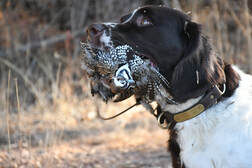
Powder has been a great companion to me. She is MY dog without question, and well in tune with me as one would hope (expect) from a Medical Alert Service Dog. In the field she has been a consistent producer, best yet she has become more proficient with each passing year. I have always wanted to do more with her steadiness for a long time now and this summer finally presented the opportunity I have been looking for!
This little video is kind of a big deal since Powder has spent most of her life treating gunfire in the field the same way Usain Bolt treated a starter's pistol sounding off! I had hoped to work on this last season, but she was injured, then pregnant, and went straight into hunting season just after the pup left. At 8 years of age, and only 4 dedicated training sessions for her this training season she now understands being steady to wing, shot, and release. So here we are, Team Hunting with Tule and Powder. This is their first co-session together. Tule did a great job of supporting Powder's initial point, so I gave her permission to come up and establish her own point, which she took advantage of. They worked well (even though Powder was a bit slippery as I walked in) and were nice and steady, overall, I'm really happy with them both. We use structure over force and high pressure. For her to demonstrate this level of steadiness with another dog in the mix is pretty awesome. by Mark Dinsmore of L'Etoile du Nord Kennels Editor’s Note Well maybe not, since I am borrowing this from a breeder I have followed for the past decade, and odds are he has been inspired by other serious breeders and maybe a serious client… So, these aren’t my words, but we do share sentiment on how many prospective clients give too many breeders (fill in the breed of your choice, this isn’t a Drent or Spinone specific thing) an easy pass. I have permission to post this and have made a few light edits, mostly grammar and format for readability since this was originally a multi-part post. I will identify any additional thought(s) I have added with (Ed.). So without further ado: One Breeder's Perspective There has been an explosion of people starting to have litters (most certainly since the pandemic, Ed.). So how do you know if they are knowledgeable and have dogs that are worthy of breeding? Frankly, you don’t and many are not. I have decided to give my perspective on what someone looking at getting a puppy should be looking for, and some of the questions you should be asking. Hunting I see a lot of people advertising puppies out of "Great" hunting parents. In fact, I don't think I have ever seen someone advertise anything less than that. Really? Every one of those dogs is a GREAT hunter. Says who? Sorry but reality is such that they all can't be great. Secondly, who is making that judgment? Questions that should be asked: First and foremost, can you go see the dog hunt? It is the old adage, seeing is believing. At a minimum, the breeder should be able to have a video for you to see of their dogs hunting. What are they hunting? Wild Birds? Pen raised birds. It does make a difference. Wild birds are by definition wild. They will not tolerate a dog that is a sloppy hunter. A dog pressures the bird too much, the bird leaves. A pen raised bird will often just sit there. It doesn't matter that the dog is inches from it, frankly it has very little survival instinct or skills, it has never needed them. I have often seen where someone has had to pick up the bird and throw it, to get it to maybe fly. Also, a dog often doesn't need to hunt to find birds that have been put out for it. It is just an Easter Egg hunt. I understand that it can be hard for some people to hunt wild birds, and hence hunt planted birds. I will say at least the dog is getting to see some birds, but please don't say it is a great hunter, as you have no way of knowing if that is true. How often do the dogs get to hunt? A couple of times a year for an hour or so? Doesn't really tell you much about the dog’s ability. To know just how good of a hunter a dog is, it needs to get out A LOT. It needs to hunt when the birds are plentiful, and more importantly when the birds are scarce. The truly great dogs will hunt all day to find that one bird, and not only will they be hunting, but they will also be hunting HARD. I would caution you to take what you hear about their dogs being great, with a grain of salt. Remember, it is one person's opinion. Ask hard questions. Training A bird dog is just that, a hunter of birds. But without training how can a dog rise to its true potential? Not all dogs are created equal. Training separates the wheat from the chaff. A Breeder needs to train their dog, before they can brag about how good they are. It is a question a prospective buyer should be asking. Training shows a breeder a number of things. Does the dog have the brain and mindset to be able to handle training? Training is stressful for dogs, just as it is for humans. Not all dogs can handle that. It shows how quickly a dog can adapt to new situations, and trust me, they must be able to adapt in the field while hunting. It shows what level of intelligence a dog has. Dogs are not robots; they must be able to think in the field and make decisions while they are hunting. They must be able to learn where birds are likely to be. Training also shows biddability, the willingness to work with you. So, your dog is a "Natural" and doesn't need to be trained. Sorry but NOPE. No one can tell me their dog wouldn't be better without training, not to mention without training you are not able evaluate to the afford mentioned comments on training. Case in point. Many of you have probably heard of a dog by the name of Vernon de L'Escarbot. Vern was a "Natural" at 4 months of age. He ran the field well, quartering, and always turning into the wind. He found and pointed birds and was staunch. He retrieved to hand starting with his first ever shot bird. Did he need to be trained. ABSOLUTELY. He would never have achieved the heights without the training, plus I would have not known just how good he truly was. ALL dogs will benefit from training. When asking a breeder how well their dogs are trained, don't accept them saying they are "Naturals", frankly in my opinion that is just a copout. So, you are not as lucky as I am to live in the country with wide open tracts of land to run on, nor birds to train with. Send the dog out to a trainer. How can you say it is too expensive to do that, if you are making money selling the puppies out of those dogs? There are things I can't do training wise. Right now, I have a young dog with a trainer to be trained to be handled off a horse. I don't have a horse at this time, so I can't train him. I went online, posted what I was looking for, Found, met with and dropped off Styx for training with the trainer, all in less than 24 hours. (We too needed a trainer with a horse, we did our own search, made the appointment, and was part of the training event. We did what was needed to ensure our dog was set up for success. It was a super cool afternoon to boot, Ed.). A reputable trainer will have trained the dogs they are breeding. That doesn't mean they have to fully broke, but they need to go through some level of formal training to learn their strengths and weaknesses, and suitability for breeding. Knowledge of the breed A reputable breeder should possess a good amount of knowledge of the breed. It doesn’t mean they have to know everything, but they should have a good grasp on many subjects. At a minimum: A breeder should know the history of the breed. What the conformation standard of the breed is and where their dogs fit in that. They should be able to articulate why their dogs are in standard and not just say they are in standard. Be able to list strengths and more importantly weaknesses, and EVERY DOG has weaknesses. What the working standard of the breed is, meaning how they are supposed to hunt, and not simply say their dogs are good or great hunters. Every single one says they have good or great hunters. Do you really think every dog is great? They should be able to tell you exactly why they are great, based on the working standard, not based on what their opinion is. Sadly, most people don’t know how the dogs are supposed to hunt. A breeder should know the lineage of their dogs, not just say they are great lines, but rather why they are great lines and what the titles mean. I am amazed when someone says they are “Champion lines” but then don’t even know what the titles mean and the requirements to achieve them. Always remember a pedigree is just a piece of paper. Too many people just breed dogs based that piece of paper, not based on the actual dog. Remember, you are buying a dog, not a piece of paper! Do your due diligence and ask questions. A reputable breeder wants questions (Ed.). If they can’t answer your questions or give you vague answers, is that what you want? I suspect you aren’t looking for a vague dog. Conformation, aka the breed standard. What is conformation, and what does it have to do with the breed standard? Is it important? The simple answer to the second question is a resounding YES!! A breed standard is how we define a dog breed. It lists out the attributes a dog is supposed to have to be considered a particular breed. Without breed standards, simply put, we don't have individual dog breeds. Surprisingly, and more so, sadly, a lot of people breeding dogs don't think it is that big of a deal. SERIOUSLY??!! All they care about is function in the field (or some other narrow band of traits, Ed.). That is a ridiculous assertion. A breed standard dictates how a dog moves in the field and hunts (and quite possibly much more depending upon the breed and its standard, Ed.). If a dog is out of standard, it may not run properly, and that leads to decreased stamina, and wear on the dog's joints. Which can lead to increased (number of and severity of, Ed.) injuries and shorten the hunting career of a dog. In this regard a breed standard is vitally important. Conformation is how well a dog adheres to the breed standard. No dog is perfect, let me repeat that, NO DOG IS PERFECT! All dogs have areas where they are weaker, as well as areas where they are stronger. In France, I don't know about the rest of Europe, to be registered a dog must go in front of a Conformateur, after the age of one. If they don't meet a minimum standard, they cannot be registered. (This is not common in Europe, I've shown dogs in the Netherlands, Spain and Portugal, but I see a tremendous amount of value in such a system. The Dutch have Breeder's Day where mated pairs of dogs are invited to be shown with their offspring as a unit and individually in an effort to gauge the success of creating the next generation of Drents. This is an ideal time to learn about the breed, Ed.). In the show ring dogs are rated, Excellent, Very Good, Good, Insufficient. At the CEB-US dogs are given a written evaluation so a breeder can know the strengths and weaknesses of their dogs (At Breeder's Day and other similarly formatted shows Drents are given a detailed written evaluation much in the same way, Ed.). Remember, the evaluation is only as good as the Judge (italics, Ed.), so things do have to be taken with a grain of salt (No truer words have been spoken or written! Ed.). They don't always get an expert for the breed to do it, and yes that can make a difference. (In North America there are no qualified judges for the Drent, and for the Spinone not all approved judges are well versed in the breed standard oftentimes selecting a few elements and hanging the whole enchilada on that versus a balanced approach...but I digress. In short don't rely on a judge to be the one to tell you about your dog - learn the breed, what's right and what's not, Ed.). How does this all apply to breeding, you ask? Well, if you don't know the weaknesses of your dog, how can you improve it? Knowledge is power, the more knowledge you have of your breeding dog, the better decision(s) you can make when it comes to pairing dogs. One of the purposes of breeding is to better the breed, you need that knowledge to be able to attempt to do that. Sadly, right now, as far as I can tell, the purpose of a lot of people breeding dogs is to make some money (Breeding dogs to make money in my experience is laughable, Ed.). It is not a bad thing to make money, but it is a bad thing if you don't really know anything about the breed or the dogs you are using, because then you are only doing it to (try to, Ed.) make money. Remember, you should also be trying to better the breed. Without a doubt some breeders have a lot of knowledge about the breed, but sadly most do not. Try asking the breeder you are talking to, "Where are your dogs lacking?" I would be willing to bet you will be greeted with a pause, if you even get an answer at all, and then a response that says their dogs have great conformation, or something like that. That is not an answer to what you asked. I can tell you the strengths of all my dogs, and more importantly the weaknesses, any breeder should be able to do that (we can as well and happily bore you to tears talking each dog's ups and downs, Ed.). Remember, knowledge is power.
|
Categories
All
Our YouTube Content
Two GunI'm just a guy suffering with an infatuation with gundogs since childhood. Forty some years later this is what you get. Archives
March 2024
|
|
|
